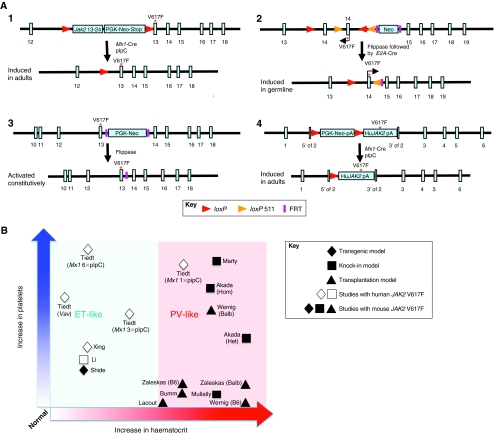Fig. 1.
Genetic strategies for generating mouse models of JAK2V617F-positive MPNs, and the phenotypic characteristics of each. (A) Schematic representation of the targeting strategies of four knock-in models. In the Akada et al. (Akada et al., 2010) model (1), the conditional knock-in allele was generated by introducing a V617F mutation construct including the floxed Jak2 cDNA (exons 13–24) with a PGK-Neo-stop cassette in intron 12 of the mouse Jak2 gene. Upon Cre recombination and removal of the floxed sequence, mouse JAK2V617F was expressed under the control of the endogenous mouse Jak2 regulatory elements. In the model by Mullally et al. (Mullally et al., 2010) (2), the conditional knock-in allele was engineered to have a point mutation in exon 13 of the mouse Jak2 gene (numbered 14 in the figure) and, upon flippase (removal of Neo) and Cre (removal of wild-type exon 14) recombination, the mouse JAK2V617F was expressed under the control of the endogenous mouse Jak2 regulatory elements. In the Marty et al. (Marty et al., 2010) model (3), the constitutive knock-in allele was engineered to have a point mutation in exon 13 of the mouse Jak2 gene with a PGK-Neo cassette flanked by flippase recognition target (FRT) in intron 13. The PGK-Neo cassette can be removed by flippase recombination. In the Li et al. (Li et al., 2010) model (4), the conditional knock-in allele was generated by inserting a floxed PGK-Neo-polyA-stop cassette preceding the human JAK2V617F cDNA into the translation start site in exon 2 of the mouse Jak2 locus. Upon Cre recombination, human JAK2V617F was expressed under the control of the endogenous mouse Jak2 regulatory elements. Red asterisks indicate where the mutation is introduced. (B) Approximate increase (relative to normal control) in haematocrit (x-axis) and platelet counts (y-axis) for the transplantation, transgenic models and knock-in mouse models. Open data points indicate studies using human JAK2V617F, whereas filled symbols are studies that use mouse JAK2V617F. The shaded red area indicates models that exhibit a PV-like phenotype and the shaded blue area indicates models that resemble an ET-like phenotype. See reference list for full references.

